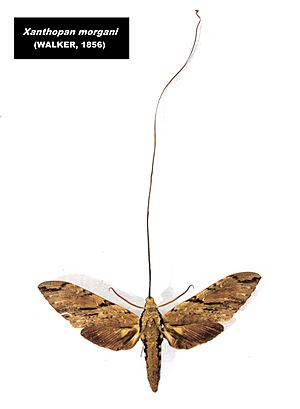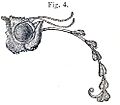Fertilisation of Orchids facts for kids

The title page of the 1877 edition
of Fertilisation of Orchids |
|
| Author | Charles Darwin |
|---|---|
| Country | United Kingdom |
| Language | English |
| Subject | Natural selection Botany |
| Publisher | John Murray |
|
Publication date
|
15 May 1862 |
| Media type | print (Hardback) |
| Pages | vi + 365 |
| OCLC | 1250711 |

Fertilisation of Orchids is a famous book by Charles Darwin. It was published on May 15, 1862. The full title was On the various contrivances by which British and foreign orchids are fertilised by insects, and on the good effects of intercrossing.
In this book, Darwin explored how orchids and insects work together. His earlier book, The Origin of Species, had only briefly mentioned how insects help plants reproduce. Darwin found studying orchids to be a fun break from his other writing. He did many interesting experiments and got help from his family, friends, and other scientists.
Contents
Darwin's Big Ideas
This book was Darwin's first detailed look at natural selection in action. It showed how complex relationships in nature lead to co-evolution. This means that two different species, like orchids and insects, evolve together.
How Orchids and Insects Evolve Together
Darwin explained that orchids and insects have special features that help them survive. These features developed over a long time. The book helped scientists understand how plants and insects depend on each other. It also made people more interested in how insects help flowers with pollination.
Darwin believed that natural selection leads to many different forms of life. This happens because cross-fertilisation (when plants mix pollen) is very helpful. Even though not many people bought the book, it made Darwin a respected botanist. Orchids was the first of many books he wrote about plants.
Unlocking Orchid Secrets
Darwin's book described how the special relationship between insects and plants created the beautiful and complex shapes of orchids. Many people wondered how such beautiful organisms came to be. Darwin showed that these amazing adaptations developed step by step, over a long time.
Darwin's Discoveries
Darwin carefully observed, experimented, and took apart orchid flowers. He discovered many things that no one knew before. For example, he solved the mystery of Catasetum orchids. These orchids have three very different kinds of flowers.
Darwin studied the Sack-Shaped Catasetum (Catasetum saccatum). This orchid grows in South America. He found that it shoots out its sticky pollen sacs with a lot of force when an insect touches a special hair. His friend Thomas Henry Huxley was so surprised he said, "Do you really think I can believe all that?"
Darwin's Predictions
In his book, Darwin made some famous predictions. One was about a specific orchid called Angraecum sesquipedale. This orchid has a very long tube that holds nectar. Darwin said that there must be a moth with an equally long proboscis (a straw-like mouthpart) to reach the nectar.
The Moth Discovery
His prediction came true many years later. In 1903, a moth called Xanthopan morgani praedicta was found in Madagascar. This moth had a very long proboscis, just as Darwin had predicted!
Images for kids
-
The bee orchid does not have nectar, but its labellum, imitating a female bee, attracts male bees. Darwin found that in northern Europe, it is mostly self-fertilising.
-
Head of a moth with its proboscis laden with seven pairs of pollinia from Orchis pyramidalis
-
Catasetum macrocarpum from Suriname ejects its pollen masses at insects.
-
The pollination mechanism of Orchis mascula is given as an example of a mechanism for transferring pollen to insects: the diagram from the book shows all the petals cut away except the lowest petal, the labellum, which extends back to form a tubular nectary below the column.
-
Darwin's greenhouse at Down House was extended to provide hothouses where he spent an hour or so every morning and afternoon, examining plants and planning future experiments.
See also
 In Spanish: La fecundación de las orquídeas para niños
In Spanish: La fecundación de las orquídeas para niños










